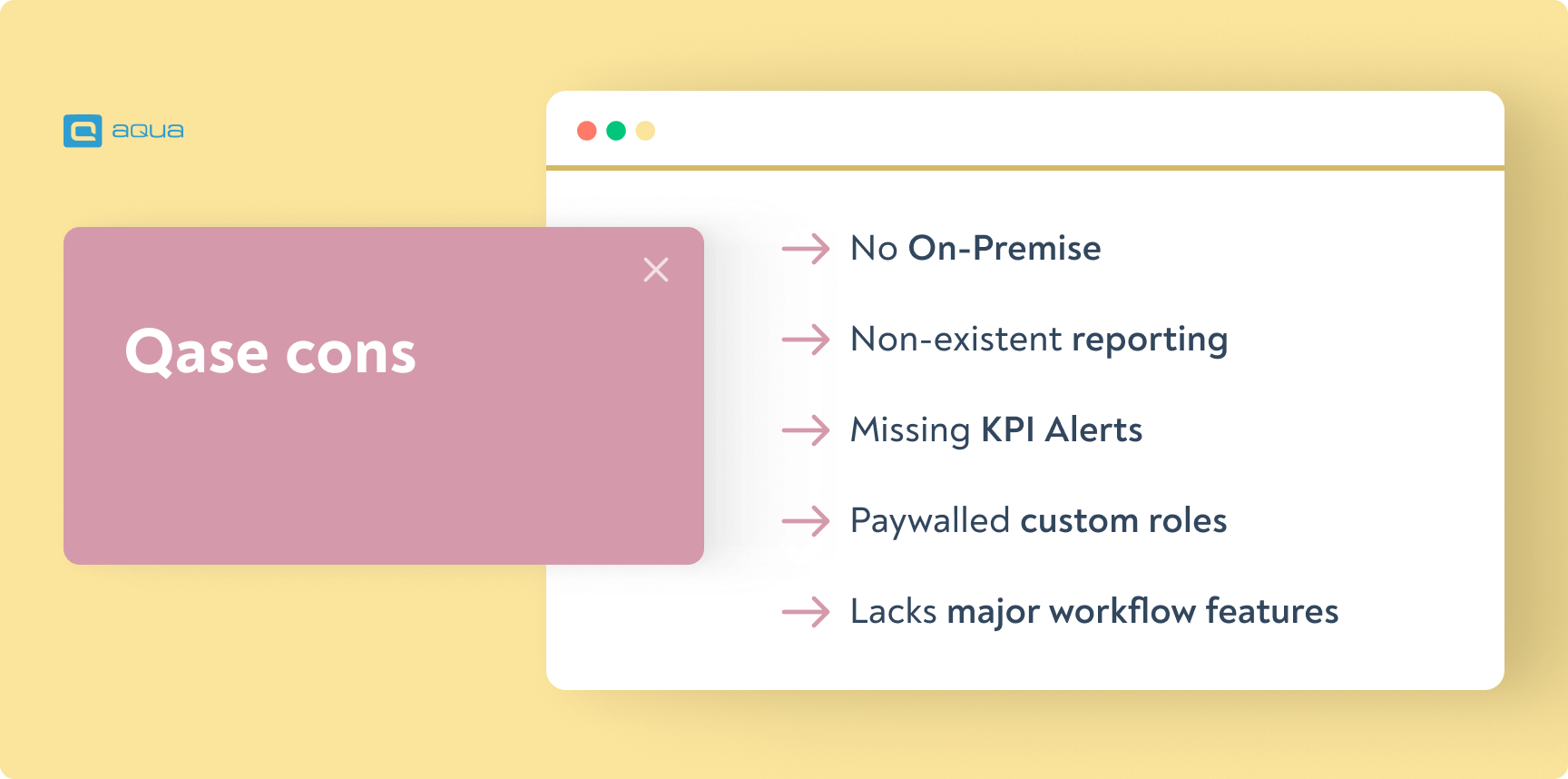About Qase
Qase was launched in late 2020, and it was developed by less than 10 people with even fewer full-time employees. The early versions focused on providing a great user experience, which also made up for the lack of a wide feature set.
3 years later, Qase is a very competent test management solution that brings most of what a QA team would need. Still, there are some compromises that are hard to address and may stay unresolved for years. Let’s take a close look.
Pros & cons of using Qase
Pros
- Qase gets the QA job done. Here are the testing features that you get:
- Test cases
- Test scenarios
- Bulk test edits
- Execution history
- Nested test cases
- Release planning
- Filters
- Tampering-proof project logging
- Qase is developed at a fast pace. While the team slowed down from monthly releases, they still push updates every 2 months. Most updates add new features (including integrations), and there is a road map to track what is coming as well.
- Qase started to offer some AI functionality. While the early beta supports generation of small tests only, this is still more than most test management solutions can do. It does not get much better even if you look at much bigger solutions and full-scale ALMs either.
Cons
- Qase does not support On-Premise deployment. It was not feasible for a new TMS without financial backing, but this option is not on the roadmap either. This omission makes using Qase difficult if not impossible in heavily regulated industries, especially in the EU.
- Reporting is non-existent. While you get serviceable dashboards, there is no functionality to further organise and transform data from your workspace. Using analytics to improve QA performance becomes harder, especially when trying to find similarities and differences across several projects.
- Dashboards are missing KPI Alerts. While a relatively rare feature, it changes how you interact with dashboards. You would be notified when there is a major change in metrics rather than look at your dashboards every day. Alas, Qase does not offer that.
- Qase paywalls custom roles behind more expensive plans. You only get 3 basic roles, which may or may not be suitable for your project and access policies. Working with freelancers becomes a headache when you can’t make a separate role for them either. Higher Qase tiers only bring custom roles instead of per user permissions, too.
- Qase lacks major work organisation features. You can’t use Views or Shared Views to quickly see a colleague’s workload or get a better understanding of the situation on the project. There are no Workflows to dictate how tickets are created and handled, which is a major asset for consistently creating tests and dealing with bugs.

Here are a couple of reviews that highlight the positives and negatives of using Qase:
“The main thing which got us using Qase was their UX, which is way more convenient to use than most of the competition.
There is room for improvement, such as reporting — especially cross-team reporting and building holistic views on how all projects are doing across the company”.
“There is one area where I feel Qase could improve: the process of writing test steps for similar cases. While the platform provides some tools to make this easier, writing out the same steps for multiple cases with similar characteristics can still be quite time-consuming and tedious“.
List of 3 Qase alternatives
Now that you know more about Qase, let’s explore tools that do things differently or better.
Best AI and all-in-one QA: aqua
aqua has been in the market for over 10 years, but the parent andagon group dates back to 2001. The company had a decade of QA consulting in highly regulated industries for companies of any scale before it created its own solution.
This is the first solution to use the algorithm behind ChatGPT for testing with AI, almost a year earlier than Qase. Here is the current AI feature set:
- Optionally provide your past tests as context for the AI algorithm
- Generate entire tests with AI
- Cover a new requirement with tests in one click
- Update tests after a requirement was changed
- Finish test drafts in one click or iteratively with the AI chatbot
- Narrate a requirement with your voice and get a complete text ticket for it
- Remove duplicates
As a much more mature tool, aqua excels in many areas where Qase is lacking.
Pros:
- Rich AI feature set
- On-Premise, GDPR-compliant vendor Cloud, or Custom Cloud deployment
- ALM functionality
- KPI Alerts
- Rich customised reporting, including self-updating scripts and parametrisation
- Workflows and views
- 100+ per user permissions for all customers
- 12+ advanced QA integrations ou of the box
- Native 2-way Jira sync with a simple setup — use advanced aqua & Jira features in one tool
- Weekly & monthly feature releases that are well-documented in an extensive wiki
- Customer success team ready to help you via live chat, scheduled calls, or emails
Cons:
- Non-QA integrations need to be set up with REST API — but it would take only 10 minutes
- No esignature functionality
“The reporting is meaningful and provides a good basis for decisions. After the employees have used aqua, they recognize the added value very quickly.”
Find more details on our aqua vs Qase comparison page.
Or even better, see the difference for yourself.
AI-powered testing for Enterprise
Old-fashioned, but reliable alternative: Micro Focus Quality Center
If you are looking for something completely different, Quality Center is the right tool. It is one of the longest-running Enterprise solutions with the feature maturity (and pricing) to match.
Pros:
- Polished and proven QA experience
- On-Premise & Cloud deployment
- Excellent dashboard including KPI alerts
- Solid reporting
Cons:
- Limited item history management
- Just 3 QA integrations out of the box
- Role permissions only
- $55,000+VAT per year before any licence costs
- No AI functionality
- Yearly feature releases only
“Quality Center is overall good, for non-agile products especially. It is a quality product that doesn't run into problems or issues — very enterprise-grade.
The way that the functionality is organised (requirements - plans - test - runs - reports) makes a lot of sense. The traceability across the phases of the release works really well.
It is just difficult to transpose the way this tool is organised to Agile sprints and releases. It requires substantial effort to make it work in an Agile environment.”
Closest sidegrade: Kualitee
If you are looking for more of the same, Kualitee is one of the best Qase alternatives. As a fairly fresh tool, it shares many pros and cons of Qase including aggressive effort to increase the market share.
Pros:
- Sufficient QA functionality
- Solid dashboards
- Reporting functionality available
Cons:
- No AI-powered testing
- Uninspiring UX compared to other tools on the list
- Cloud only
- Reports are limited to templated only
- Custom roles but no per user permissions
- Can’t handle requirements management
- Just 1 native QA integration (REST API still available)
- Poor traceability
“The user interface is not friendly, but the features are very good. Sometimes it takes time to load, and the page is not responsive. It would be great if adding test cases into the test execution cycle was faster.”
Conclusion
While modern tools are too good to find a free Qase alternative, we have gathered a few options for companies of any size. Whether its reliability or AI functionality, they can handle QA and even the entire application lifecycle areas better than Qase does.
Overall, aqua is the most balanced upgrade from Qase. You are getting bleeding-edge QA functionality, On-Premise support, and actual Enterprise-grade reporting. Workflow functionality is a major time saver for both setting up new projects and scaling them up.
Feature-richest Qase alternative


















